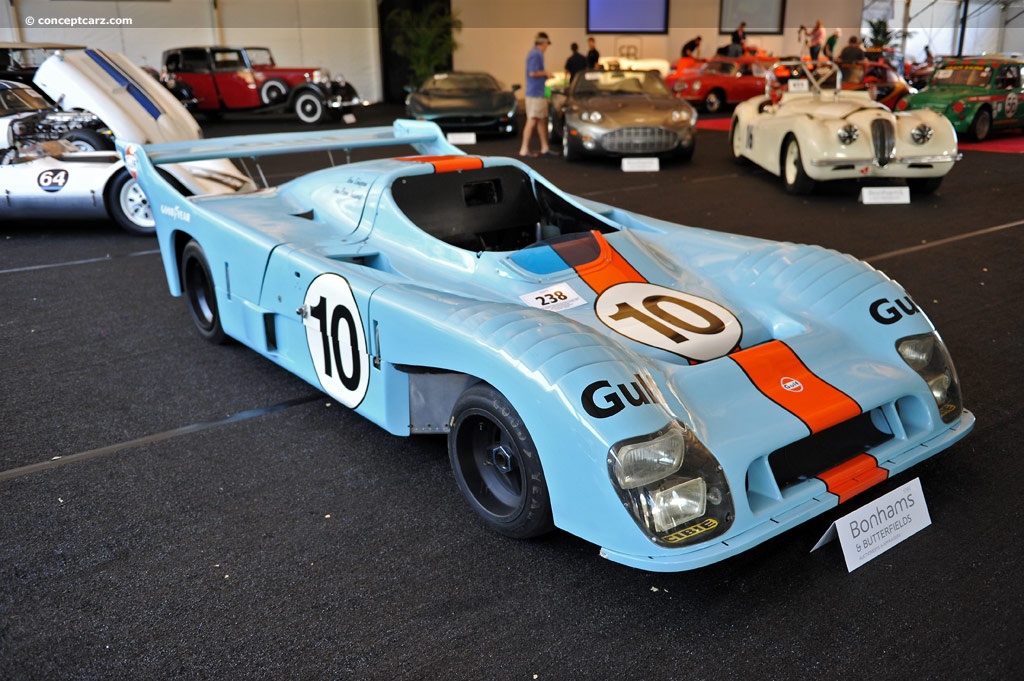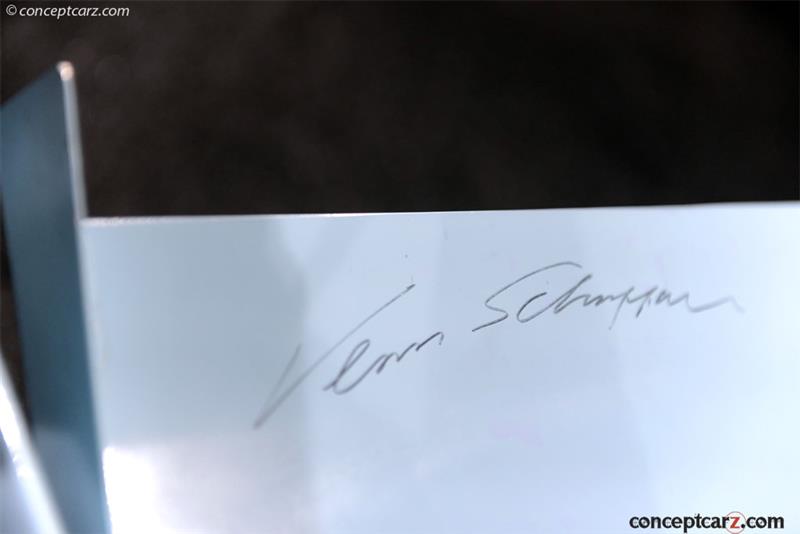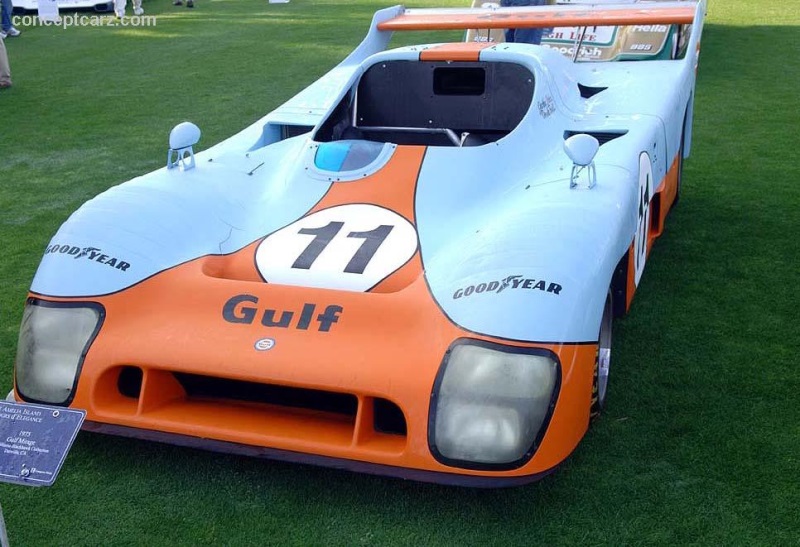Image credit: © conceptcarz.com (Reproduction Or reuse prohibited).

The Gulf-JW Automotive Racing Team enjoyed a successful World Championship racing career in the late 1960s and early 1970s. Their management team consisted of John Wyer, David Yorke, and Arnold Stafford. Along with the engineering direction of ex-Aston Martin Works team member John Horsman, the Gulf-JW had earned world titles with the Ford GT40 and Porsche 917 and 908/3 cars. They had campaigned the Mirage endurance racing prototypes, beginning with the reduced-frontal-area Mirage M1 version of the GT40.
John Wyer and the John Wyer Automotive team commissioned the construction of a new sports racing car to replace their Porsche 917. The new Mirage, the M6, used the lessons learned from the M3 of the late 1960s and took its development even further. Power was from the Formula 1 sourced Cosworth DFV V8 3-liter engine.
Designer Len Bailey, who had worked with Wyer during the development of the GT40 and the Mirage M1, was tasked with creating the design for the new M6. The chassis was created from a riveted aluminum monocoque and reinforced with steel bulkheads. The engine and the Hewland gearbox acted as stressed members for the chassis. Ventilated disc brakes were mounted out-board in the front and the back, and the car was suspended by double wishbones in the front and parallel links in the rear. The body of the car was made from lightweight yet rigid fiberglass.
The chassis was completed in March of 1972 and given to driver Derek Bell for testing. There were only a few weeks to prepare the car for its debut at the Sebring 12 Hour race. The Gulf Team driving the Mirage M6 in Florida consisted of Bell and the 1971 LeMans winner Gijs van Lennep. The car qualified seventh but would retire from the race after just 48 laps due to mechanical issues. Much of the first season would have similar results as the car continued to endure teething problems, especially from the V8 engine. The intense vibration from the engine caused components to brake prematurely. Notable finishes during the season were a four-place at the Spa 10000km and Nurburgring 1000km and a third at Watkins Glen. The second M6 made its racing debut at the Glen.
A third Mirage was completed near the end of the season, and this example was powered by a Harry Weslakes V12 powerplant. The engine was more powerful than the V8 but also heavier. It had better reliability because it was smoother, but it had difficulty matching the performance of the V8-equipped cars. As the season ended - and preparations were made for the start of the 1973 season - testing and development continued on the V8 and V12 cars. As the season drew closer, the decision was made to drop the V12 car and focus on M6s with the V8 power.
The development of the cars paid off, as a victory was earned at the Spa 1000 km race. Bell and Mike Hailwood earned the M6 their first victory. The second car finished in second place.
For LeMans, the Gulf Racing Team fielded two V8 M6s and a coupe version of the V12 engined chassis. The body design was perfect for the high-speed track, but the engine was problematic, failing to start after each fuel stop. Of the two V8-powered M6s, one withdrew after just 29 laps due to gearbox issues. After lengthy repairs, the car returned but not as a competitor. Its presence was merely for testing purposes and to gain information to help better prepare the car. This experiment was soon over after the engine seized. The other car was involved in an accident and flipped off course.
After the season, four of the five cars were rebuilt as the Gulf Mirage GR7s. The wings were moved further back, titanium parts were used to reduce the overall weight, and the nose was lengthened.
At the season opener at the Monza 1000 km race, Bell set the fastest lap. He sat on the pole at Spa and finished the final three rounds of the World Championship with third-place finishes. At LeMans, the Mirage finished in a very impressive fourth place.
After Grady Davis retired from Gulf Oil, the future of the Motorsports program was jeopardized. Funding was secured for one final attempt at LeMans, and work began on preparing a suitable contender for the high-speed track - the GR8. Bailey created a longer wheelbase chassis and clothed it with an aerodynamic package designed by Horsman and Wyer. The cars had a large frontal area, low-drag body shape, and good downforce from the rear wing. Two examples were built each powered by the Cosworth DFV engines. During qualifying, the cars proved they were fast, but during the race, the engine vibration came back to haunt the cars. The leading car suffered a cracked pipe, but it was repairable. Derek Bell and Jackie Ickx continued on with the race, eventually finishing in first. The second car, driven by Schuppan and Jean-Pierre Jaussaud, finished in third.
With Gulf sponsorship at an end, the cars were sold. Both GR8s were acquired by American Harry Cluxton, and with the help of the Gulf Racing team, entered returned the cars to LeMans the following year. They would finish the race in second and fifth. The cars would return again in 1977, this time the DFV V8 engines were replaced by turbocharged Renault engines. One car would retire prematurely while the second car finished in second place, behind a Porsche 936.
The Gulf-Mirage GR8s would return to LeMans on two more occasions.
GR8/802
GR8-802 was the second GR8 built, and it was the third-place finisher at LeMans driven by Jean-Pierre Jaussaud and Vern Schuppan. It finished second the following two years. In 1978, it was re-named the Mirage M9 and again competed at LeMans, this time finishing 10th. It returned a year later to make its final attempt at an overall victory. A Cosworth engine was placed in its engine bay, and a long-tail body was fitted to the chassis. It was given the name Mirage M10 and, after a valiant attempt, was withdrawn from the race due to mechanical issues.
After its long racing career, which included five trips to LeMans, the car was given a restoration and returned to its GR8 configuration with Gulf livery. The car was part of the Rosso Bianco museum for many years before the collection was sold in 2006. It was sold by Bonhams at their Goodwood Revival auction for the sum of £370,000. In 2010, the car returned to auction, this time to Bonhams Exceptional Motorcars and Automobilia sale in Carmel, California. The car was estimated to fetch $1,300,000 - 1,600,000. Sadly, a willing buyer capable of satisfying the car's reserve was not found, and it would leave the auction unsold.By Daniel Vaughan | Oct 2010
John Wyer and the John Wyer Automotive team commissioned the construction of a new sports racing car to replace their Porsche 917. The new Mirage, the M6, used the lessons learned from the M3 of the late 1960s and took its development even further. Power was from the Formula 1 sourced Cosworth DFV V8 3-liter engine.
Designer Len Bailey, who had worked with Wyer during the development of the GT40 and the Mirage M1, was tasked with creating the design for the new M6. The chassis was created from a riveted aluminum monocoque and reinforced with steel bulkheads. The engine and the Hewland gearbox acted as stressed members for the chassis. Ventilated disc brakes were mounted out-board in the front and the back, and the car was suspended by double wishbones in the front and parallel links in the rear. The body of the car was made from lightweight yet rigid fiberglass.
The chassis was completed in March of 1972 and given to driver Derek Bell for testing. There were only a few weeks to prepare the car for its debut at the Sebring 12 Hour race. The Gulf Team driving the Mirage M6 in Florida consisted of Bell and the 1971 LeMans winner Gijs van Lennep. The car qualified seventh but would retire from the race after just 48 laps due to mechanical issues. Much of the first season would have similar results as the car continued to endure teething problems, especially from the V8 engine. The intense vibration from the engine caused components to brake prematurely. Notable finishes during the season were a four-place at the Spa 10000km and Nurburgring 1000km and a third at Watkins Glen. The second M6 made its racing debut at the Glen.
A third Mirage was completed near the end of the season, and this example was powered by a Harry Weslakes V12 powerplant. The engine was more powerful than the V8 but also heavier. It had better reliability because it was smoother, but it had difficulty matching the performance of the V8-equipped cars. As the season ended - and preparations were made for the start of the 1973 season - testing and development continued on the V8 and V12 cars. As the season drew closer, the decision was made to drop the V12 car and focus on M6s with the V8 power.
The development of the cars paid off, as a victory was earned at the Spa 1000 km race. Bell and Mike Hailwood earned the M6 their first victory. The second car finished in second place.
For LeMans, the Gulf Racing Team fielded two V8 M6s and a coupe version of the V12 engined chassis. The body design was perfect for the high-speed track, but the engine was problematic, failing to start after each fuel stop. Of the two V8-powered M6s, one withdrew after just 29 laps due to gearbox issues. After lengthy repairs, the car returned but not as a competitor. Its presence was merely for testing purposes and to gain information to help better prepare the car. This experiment was soon over after the engine seized. The other car was involved in an accident and flipped off course.
After the season, four of the five cars were rebuilt as the Gulf Mirage GR7s. The wings were moved further back, titanium parts were used to reduce the overall weight, and the nose was lengthened.
At the season opener at the Monza 1000 km race, Bell set the fastest lap. He sat on the pole at Spa and finished the final three rounds of the World Championship with third-place finishes. At LeMans, the Mirage finished in a very impressive fourth place.
After Grady Davis retired from Gulf Oil, the future of the Motorsports program was jeopardized. Funding was secured for one final attempt at LeMans, and work began on preparing a suitable contender for the high-speed track - the GR8. Bailey created a longer wheelbase chassis and clothed it with an aerodynamic package designed by Horsman and Wyer. The cars had a large frontal area, low-drag body shape, and good downforce from the rear wing. Two examples were built each powered by the Cosworth DFV engines. During qualifying, the cars proved they were fast, but during the race, the engine vibration came back to haunt the cars. The leading car suffered a cracked pipe, but it was repairable. Derek Bell and Jackie Ickx continued on with the race, eventually finishing in first. The second car, driven by Schuppan and Jean-Pierre Jaussaud, finished in third.
With Gulf sponsorship at an end, the cars were sold. Both GR8s were acquired by American Harry Cluxton, and with the help of the Gulf Racing team, entered returned the cars to LeMans the following year. They would finish the race in second and fifth. The cars would return again in 1977, this time the DFV V8 engines were replaced by turbocharged Renault engines. One car would retire prematurely while the second car finished in second place, behind a Porsche 936.
The Gulf-Mirage GR8s would return to LeMans on two more occasions.
GR8/802
GR8-802 was the second GR8 built, and it was the third-place finisher at LeMans driven by Jean-Pierre Jaussaud and Vern Schuppan. It finished second the following two years. In 1978, it was re-named the Mirage M9 and again competed at LeMans, this time finishing 10th. It returned a year later to make its final attempt at an overall victory. A Cosworth engine was placed in its engine bay, and a long-tail body was fitted to the chassis. It was given the name Mirage M10 and, after a valiant attempt, was withdrawn from the race due to mechanical issues.
After its long racing career, which included five trips to LeMans, the car was given a restoration and returned to its GR8 configuration with Gulf livery. The car was part of the Rosso Bianco museum for many years before the collection was sold in 2006. It was sold by Bonhams at their Goodwood Revival auction for the sum of £370,000. In 2010, the car returned to auction, this time to Bonhams Exceptional Motorcars and Automobilia sale in Carmel, California. The car was estimated to fetch $1,300,000 - 1,600,000. Sadly, a willing buyer capable of satisfying the car's reserve was not found, and it would leave the auction unsold.By Daniel Vaughan | Oct 2010
2018 Gooding & Company : Pebble Beach
Pre-Auction Estimates :
USD $2,500,000-USD $3,500,000
Lot was not sold
2010 Bonhams - Quail Lodge
Pre-Auction Estimates :
USD $1,300,000-USD $1,600,000
Lot was not sold
Recent Sales of the Mirage GR8
(Data based on Model Year 1975 sales)
Mirage GR8s That Failed To Sell At Auction
1975 Mirage GR8's that have appeared at auction but did not sell.
| Vehicle | Chassis | Event | High Bid | Est. Low | Est. High |
|---|---|---|---|---|---|
| 1975 Gulf-Mirage GR8 | GR8-802 | 2018 Gooding & Company : Pebble Beach | $2,500,000 | $3,500,000 | |
| 1974-75 Gulf-Cosworth GR8 Endurance Racing Sports-Prototype | 802 | 2010 Bonhams Quail Lodge | $1,300,000 | $1,600,000 |
Vehicles With Comparable Market Values
Similar sales to the range.
1975 Mirage GR8
• Additional valuation insight and sales data• History
• Specifications
• Image gallery





















































